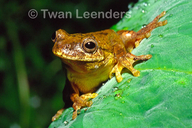|
Description
Diagnosis:Tlalocohyla loquax is a light gray or yellow to tan treefrog with a robust, medium-sized body (33-35 mm SVL in males, 38-47 mm in females) that can be distinguished by its yellow venter and bright red axilla, groin, anterior and posterior thighs, and webs (Savage 2002).
Description: Tlalocohyla loquax are medium-sized tree frogs, with adult males 33 to 45 mm in total length and adult females 38 to 47 mm, characterized by having a yellow venter and bright red or orange coloration on the backside of the thighs and on the webbing between the fingers and toes. The upper surface is smooth, while the venter is granular. The head is typically wider than long; the snout looks bluntly round from above and in profile. The eyes are large; and the tympanum is distinct as well. The diameter of the tympanum is 1/2 to 2/3 the diameter of the eyes in males, and slightly less in females (less than 1/2). Fingers are short and robust. All fingers are moderately webbed, but no nuptial thumb pads were observed in males (Gaige and Stuart 1934; Savage 2002).
At night, the dorsal surfaces are typically yellow to reddish brown. During the day, the upper surface is yellow to pale gray, almost white. Often some small dark brown mottling flecks are seen. Most notably, webs and concealed surfaces are bright red, the venter is lemon yellow, and the iris reddish tan. The only other Costa Rican tree frog with red webbing on hands and feet is Hypsiboas rufitelus, which does not have a yellow venter. (Savage 2002).
At stage 25, the tadpole measures 45 mm in total length. The body is ovoid. The tail is moderate and acuminate, with high caudal fins and a pointed tail tip. Eyes and nostrils are directed dorsolaterally, with mouth anteroventral. The oral disc is small and complete and has moderate, finely serrated beaks, 2/3 rows of denticles (A2 with a wide medial gap, P2 with a narrow gap, P3 extremely short), two rows of papillae around the edges of the disc except for above the mouth, and additional papillae at the level of the jaw angle. The spiracle is lateral and sinistral; The vent tube is dextral. The body is light in color with dark spots between the eyes and a distinct V-shaped dark mark on the snout pointing towards spots between the eyes. The venter is metallic silver or copper and the fins are mottled with dark gray pigments. The iris is orange (Savage 2002). Distribution and Habitat
Country distribution from AmphibiaWeb's database: Belize, Costa Rica, Guatemala, Honduras, Mexico, Nicaragua
This species is found in humid lowlands and premontane slopes of the Atlantic versant from southern Veracruz, Mexico, to south-central eastern Costa Rica. In Costa Rica, it is found exclusively in the northeast, at elevations below 1,000 m (3,300 ft) (Leenders 2001).
Their habitat is typically around temporary ponds in Lowland Moist and Wet Forest zones and marginally in Premontane Wet Forest and Rainforest (Savage 2002). Life History, Abundance, Activity, and Special Behaviors
This frog makes a series of “kaaack” or “wonk” notes that resemble the honking of geese. These notes repeat at intervals of 900 milliseconds to 5 seconds and last 50 to 160 milliseconds, with a repetition rate of 9 to 62 per minute. Its call is poorly modulated, with a dominant frequency ranging between 2.1 to 2.4 Hz (Savage 2002).
Tlalocohyla loquax is a relatively uncommon nocturnal species that primarily breeds in deep bodies of standing water (both permanent and temporary). Males call throughout the wet season with a loud "kaaack" from floating leaves in the deepest parts of the breeding ponds. Although this species is not an explosive breeder, its reproduction peaks in July and early August, in mid-rainy season. Each clutch contains about 250 eggs, and forms a large gelatinous mass that is attached to vegetation near the water surface. Tadpoles are nektonic and live away from the shore in the deepest parts of the breeding pond (Savage 2002). Trends and Threats
This species is adaptable and can persist in disturbed habitats if there is deep water and at least some vegetation available. It occurs in many protected areas (Santos-Barrera et al. 2008). Comments
A Spanish-language species account can be found at the website of Instituto Nacional de Biodiversidad (INBio).
This species was first described by Gaige and Stuart in 1934.
References
Gaige, H. T., and Stuart, L. C. (1934). ''A new Hyla from Guatemala.'' Occasional Papers of the Museum of Zoology, University of Michigan, 281, 1-3.
Leenders, T. (2001). A Guide to Amphibians And Reptiles of Costa Rica. Zona Tropical, Miami.
Santos-Barrera, G., Chaves, G., Savage, J., Wilson, L. D., and Bolaños, F. (2008). Tlalocohyla loquax. In: IUCN 2010. IUCN Red List of Threatened Species. Version 2010.1. www.iucnredlist.org. Downloaded on 05 May 2010.
Savage, J. M. (2002). The Amphibians and Reptiles of Costa Rica:a herpetofauna between two continents, between two seas. University of Chicago Press, Chicago, Illinois, USA and London.
Originally submitted by: Nelly Chow (first posted 2009-11-02)
Edited by: Kellie Whittaker (2010-05-05)Species Account Citation: AmphibiaWeb 2010 Tlalocohyla loquax: Mahogany Treefrog <https://amphibiaweb.org/species/851> University of California, Berkeley, CA, USA. Accessed Jan 31, 2025.
Feedback or comments about this page.
Citation: AmphibiaWeb. 2025. <https://amphibiaweb.org> University of California, Berkeley, CA, USA. Accessed 31 Jan 2025.
AmphibiaWeb's policy on data use.
|
